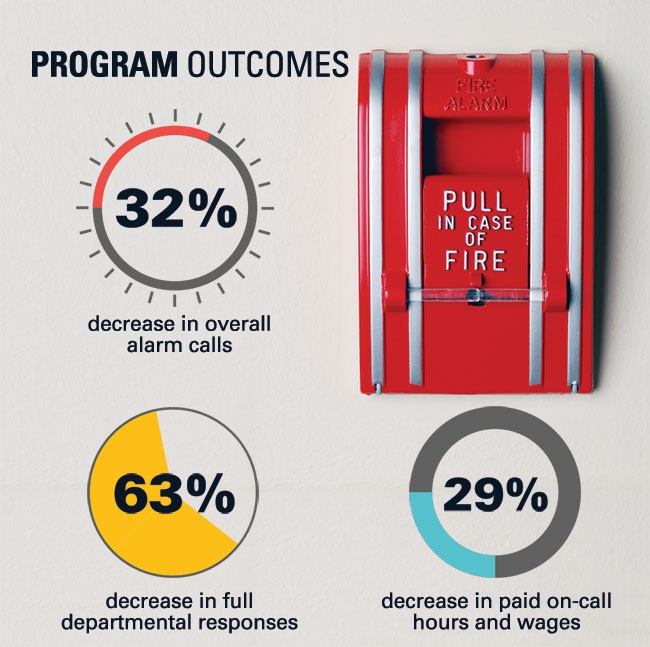
Features
Leadership
Leading Edge: False alarm strategies save time and money
Volunteer and composite fire services respond to a very high percentage of fire alarms that are unwarranted or false. Responding to these incidents can negatively impact a department by creating increased call volume, higher enforcement costs, increased cost of paid on-call wages, inconvenience to volunteer firefighters, among other issues.
November 9, 2017
By Don Jolley
 Don Jolley explains how creating a false alarm strategy allowed Pitt Meadows Fire & Rescue Service to function more efficiently.
Don Jolley explains how creating a false alarm strategy allowed Pitt Meadows Fire & Rescue Service to function more efficiently.Between 2009 and 2015, Pitt Meadows Fire & Rescue Service responded to 714 alarms-ringing calls of all types: residential, commercial, multi-family, school, industry. Of those calls, 98.3 per cent of the responses were determined to be false with no legitimate cause. The remaining 1.7 per cent had an identified cause, but none were of any significant nature, for example, burnt food or minor electrical fires.
Fire services in North America, Europe and Australia have conducted research that confirms our local data, positing that traditional fire alarm responses are inefficient, create risk and generate a burden on operations. Pitt Meadows data shows that the chances of an actual emergency are minimal when only a single fire protection system is activated. Conversely, it is clear that when a legitimate event does occur, a secondary notification (for example, a fire alarm plus a 911 caller) is overwhelmingly present.
Some jurisdictions in Canada and the United States have made changes in both the number of apparatus responding and mode of travel (emergency vs. routine). Meanwhile, others in Europe and Australia are sending small rapid response crews to alarm incidents. These crews are able to effectively mitigate the vast majority of alarms without incurring undue risk.
In April 2016, Pitt Meadows implemented its Unwanted False Alarm Reduction Strategy. The strategy recognized that our response profile, alarm monitoring and notification protocols required modifications.
As a result, our service was able to reduce the number of apparatus responding to alarms-ringing calls at residential homes, multi-family, commercial and industrial properties that have fire sprinkler protection systems. In appropriate cases, the department also changed secondary apparatus to routine response when a first due or duty officer is on scene. For multi-family, commercial or industrial properties that were without a sprinkler system, a full departmental response was maintained.
In addition, our department made changes to the alarm notification protocol for both property owners and alarm-monitoring stations.
For single-family homes where the fire/smoke alarm system is monitored, alarm-monitoring companies should verify the alarm via call back to the home prior to activating emergency responders. If a false alarm cannot be verified, responders will be sent.
For multi-family, commercial, and industrial buildings that are required to have monitored fire alarm systems, the current code provision that allows for call back verification should be utilized. If fire dispatch cannot verify if a call is a false alarm, responders will be sent immediately.
If at any time fire dispatch suspects a significant emergency, a full departmental response will be initiated. While the department cannot compel an organization to utilize verification, we are educating the public about the benefits of doing so.
The department also made significant changes our public education and awareness efforts. Reminder stickers were put in place for all alarm systems to remind service technicians to use test settings during maintenance. Requests were made for property owners to notify the fire service of any home renovations that could cause accidental alarm activation. In addition, fire inspectors are taking a more aggressive approach to enforcement requirements, and letters were sent to residents to inform them that smoke alarms should not be interconnected with the home security monitoring system.
Any or all of these changes and enhancements can easily be made by any department, or modified to fit local conditions and resources.
One year later, the initiative has generated positive outcomes. There was a 32 per cent decrease in overall alarm calls (the second fewest since 2008) and a similar decrease in billable false alarm fines despite no change in call volume. There was a 63 per cent reduction in full departmental responses, leading to a 29 per cent decrease in paid on-call hours and wages. Most importantly, there were no occurrences of inappropriate dispatching or significant events with reduced resources. Further, the decreased number of emergency responses reduced risk to both firefighters and public.
To date, there have not been any negative impacts associated with the strategy. The overall benefits of the Unwanted Fire Alarm Reduction Strategy can be summarized as:
- Decreased operational and financial burden on the fire service for both firefighters and administration.
- A safer community, resulting from better compliance with fire code and bylaw requirements.
- Reduced risk to firefighters and the public.
- Minimal enforcement action for billable false alarms.
Fire services of all sizes should be looking at and adopting measures to reduce the burden on their organization and personnel. Community compliance can be achieved through targeted education efforts so property owners adopt more appropriate fire protection system maintenance programs, while lowering cost and burden on the local fire department.
Don Jolley is the fire chief for the City of Pitt Meadows, and the first vice-president of the Fire Chiefs’ Association of British Columbia. Contact him at djolley@pittmeadows.bc.ca
Print this page
Advertisement
- Well-being: 6 ways firefighters can get better sleep
- Volunteer Vision: Roadside memorials can remind first responders of trauma